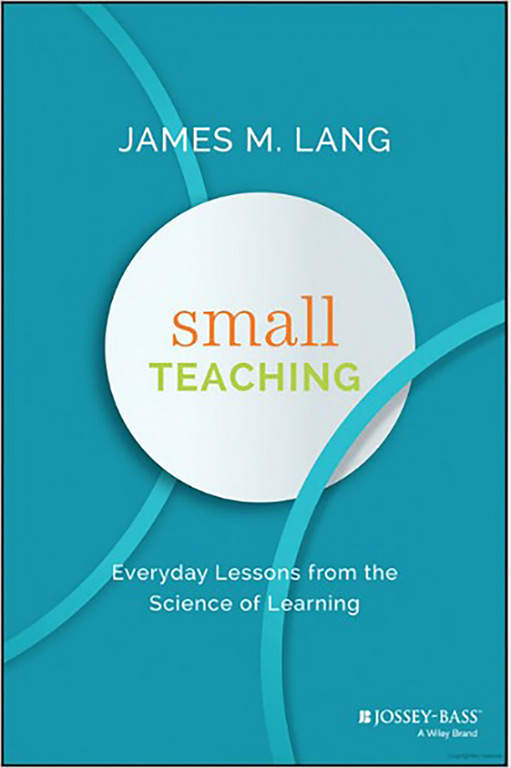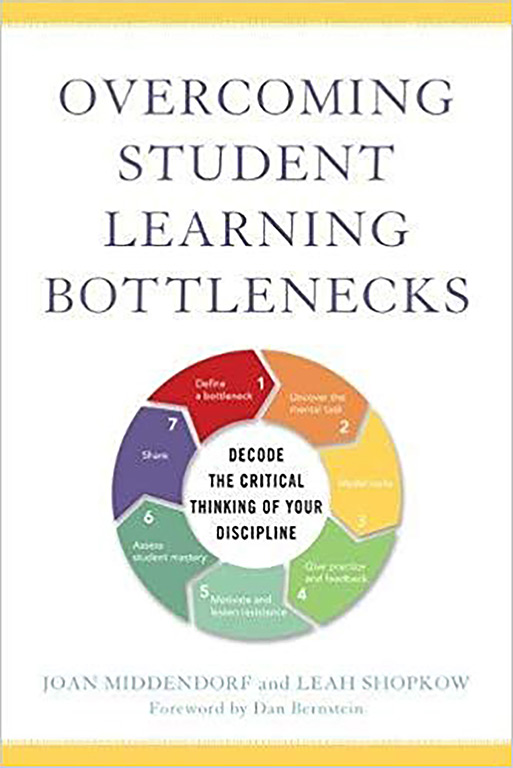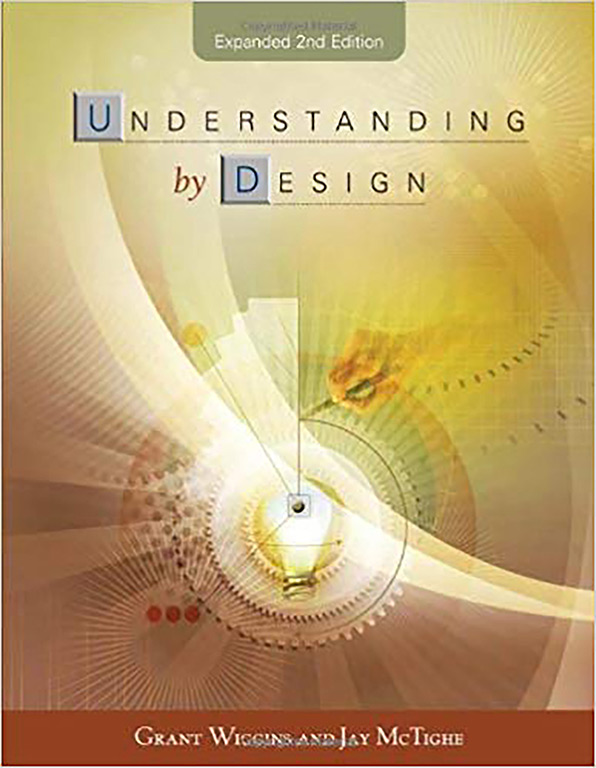Explore a “foot of books”—a list that might take up 12 inches on your bookshelf—about the practice of teaching and learning at the college level. The pages here are filled with accessible pedagogical research, useful examples, immediate applications, tips, techniques, strategies, and suggestions for further research.
Select book recommendations on teaching and learning
Overviews

Bain, K. What the Best College Teachers Do (2011). Harvard University Press.
Over the course of 15 years, Ken Bain and his research team studied 100 top-performing college professors from all over the United States, conducting qualitative research to determine the habits, interactions, and teaching styles of professors who achieved the best educational results. Bain defines results as making “sustained, substantial, and positive influence on how . . . students think, act, and feel.”
The book offers a very accessible and engaging read, exploring topics such as how the best professors prepare to teach, conduct class, evaluate students, and interact with students. It is interesting to compare one’s own teaching to what the text describes.

McKeachie, W., & Svinicki, M. (2013). McKeachie's Teaching Tips: Strategies, Research, and Theory for College and University Teachers, 14th Edition. Cengage Learning.
As evidenced by the number of editions, this book is immensely popular and helpful to anyone who teaches in higher education, and particularly useful for those new to teaching at the college level. Written by stars from the teaching and learning community, this book contains 23 chapters on just about every aspect of college teaching one could imagine. Each chapter ends with a list of supplementary reading, listing further resources for exploration and research for each topic.
If I had to choose one book on college pedagogy to own, it would be this one. Not only does it have the answers to many questions, but it also provides a gateway to further study by topic.
Applied Learning Theory

Ambrose, S. A., Bridges, M. W., DiPietro, M., Lovett, M. C., & Norman, M. K. (2010). How Learning Works: Seven Research-Based Principles for Smart Teaching. Jossey-Bass.
Organized into seven chapters titled as questions any faculty member might ask, this book, written by five teaching and learning experts, bridges the gap between learning theory and college teaching practice. Filled with examples, stories, and practical applications, the text is imminently applicable and gets right to the heart of the various concerns of the professoriate. Among the chapter questions are: How does prior knowledge affect learning? How do students develop mastery? What’s important about the climate of the course? What motivates students to learn?
Readers will find this book very accessible and anything but dry. The text concludes with eight appendices for immediate application.

Lang, J. M. (2016). Small Teaching: Everyday Lessons from the Science of Learning. Jossey-Bass.
In this incredibly useful book, James Lang presents a collection of small classroom activities and teaching strategies that are soundly grounded in research about how students learn. More than just a collection of teaching tips, this book provides a framework by which instructors can start making significant improvements to their teaching through relatively small steps that impact student knowledge, understanding, and motivation. The book is an engaging read and provides a balance of use-it-on-Monday teaching strategies and the deeper lessons about learning that underlie them.
–Greg Siering, Director, Center for Innovative Teaching and Learning

Middendorf, J., & Shopkow, L. (2017). Overcoming Student Learning Bottlenecks: Decode the Critical Thinking of Your Discipline. Stylus Publishing.
One of the most difficult aspects of teaching is recognizing and dealing with the gap in understanding between expert (teachers) and novices (students). Experts operate in a world of implicit knowledge that has long since become second nature. Problems can arise when teachers are unaware of such knowledge. For students, these manifest as learning bottlenecks.
In this book, Middendorf and Shopkow present a seven-step process for uncovering bottlenecks and determining the most effective way to enable students to surmount them. This volume will be especially helpful to teachers who recognize spots in their curriculum where students perpetually struggle to learn.
Course Design

Fink, L. D. (2013). Creating Significant Learning Experiences: An Integrated Approach to Designing College Courses. Jossey-Bass.
Fink opens his book with a brief explanation of the problem: many college courses promote superficial learning that students forget very soon after taking the class. The text, then, is about reversing this trend by planning and teaching courses that promote deep, meaningful learning that students will retain and make a part of their mental landscape.
Fink lays out his unique taxonomy of significant learning and then gives easy-to-follow step-by-step instructions on how to design and then teach courses with significant learning in mind. The text ends with an extensive list of suggested readings as well as institutional considerations of how to promote and support significant learning.

Walvoord, B. E., & Anderson, V. J. (2011). Effective Grading: A Tool for Learning and Assessment in College, 2nd Edition. Jossey-Bass.
At first glance, this book may seem misplaced—a book on grading in the course development section? The book will reappear in the grading section, but it is also rightly here. In this succinct and easy-to-read volume, Walvoord & Anderson look at grading from the perspective of assignment-based course development. A natural extension of backward course design (see Wiggins), assignment-based course design helps instructors align their learning goals with students’ goals of success (good grades).
The book also details how instructors can optimize class time and concludes with a section on assessment.

Wiggins, G. P., Wiggins, G., & McTighe, J. (2005). Understanding by Design, 2nd Edition. ASCD.
Although written for the K-12 audience, the lessons of this book are essential to effective course design and should not be overlooked. With numerous examples and case studies, Wiggins & McTighe (Pronounced like McTiger without the "r"), lay out the concept of Backward Course Design, the approach used in all of IU’s Course Development Institutes.
Backward course design begins with the instructor’s learning goals, then moves to assignments (see Walvoord & Anderson), and then to what students will do to learn and succeed on the assignments. Notably, content is only later considered.
Classroom Practice and Management

Angelo, T. A., & Cross, K. P. (1993). Classroom Assessment Techniques: A Handbook for College Teachers. Jossey-Bass.
Don’t let the date of this book deter you from reading or buying it! This book is a must-have for any college instructor. Beginning with an explanation of classroom assessment, continuing on to match learning goals and instructional methods with appropriate assessments, and culminating with a well-organized variety of 50 assessment techniques, this book is designed as a sourcebook for instructors who want to know more about their students’ learning.
Classroom Assessment Techniques (CATs) are informal (i.e., ungraded), but systematic methods by which instructors do “quick research” on the extent to which students are learning the knowledge, skills, and attitudes hoped for. Using CATs can improve improving student learning and transform hunches into data.

Harrington, C., & Zakrajsek, T. (2017). Dynamic Lecturing: Research-Based Strategies to Enhance Lecture Effectiveness. Stylus Publishing.
The recognition of new pedagogies, technologies, and even classroom architectures has led many to relegate the classroom lecture to the scrap heaps of college teaching. In this monograph, Harrington and Zakrajsek recuperate the lecture as a teaching method that, when done right, “can produce some of the highest levels of learning.” The book is organized into three parts: 1. an exploration of the lecture as a viable teaching strategy, 2. the application of research in teaching and learning to enhance lectures, and 3. guides and advice for how both to plan and evaluate lectures.
This book is easy to read and designed for college professors who use the lecture as their primary means of teaching. Ideas and tips are presented so that they can be used immediately.

Tolman, A. O., Kremling, J., & Tagg, J. (2016). Why Students Resist Learning: A Practical Model for Understanding and Helping Students. Stylus Publishing.
This book is a real gem, with a wealth of researched information about classroom management. While the book does indeed maintain a focus throughout on student resistance to learning, its topics reach far beyond that topic. One chapter, for example, looks at the concept of stereotype threat and how that could cause some students to struggle. Another chapter looks at student intellectual development, positing that a class that is pitched too far beyond where students are could cause them to give up or refuse to do the required work for the class.
Reading this book will open your eyes to the many issues at play in the college classroom, an awareness of which may be very helpful to instructors striving to create an effective learning environment.

Weimer, M. (2013). Learner-Centered Teaching: Five Key Changes to Practice, 2nd Edition. Jossey-Bass.
Based on a raft of well-established research about teaching and learning, this book takes as its point of departure the assumption that the best teaching is centered on the learner—not on the content, the teacher, or the institution. After a brief but interesting foray through the research, Weimer discusses different aspects of university teaching, explaining what needs to change, why it needs to change, and why it hasn’t changed. She then offers the reader practical suggestions to effect the change she lobbies for.
This book is not only eminently readable, but also very useful in helping college teachers develop their practice and transform their classrooms to places where optimal learning takes place.
Grading

Guskey, T. R. (2014). On Your Mark: Challenging the Conventions of Grading and Reporting. Solution Tree Press.
In a very readable 100 pages, Thomas Guskey invites us to consider the purpose of grades and rethink the many traditional grading practices that interfere with, muddy, or outright contravene that purpose. Guskey problematizes the complications of the letter grade system, arguing that simplifying the system by doing away with plusses and minuses would be better for everyone. He similarly calls into question the percentage system, where passing is 60% or higher. Why, he asks, do we need 60 points out of 100 to designate a failing grade?
Written for the K-12 audience, the book nevertheless has much to offer college instructors. Reading it will help you rethink your grading practices so grading does what you want it to do.

Nilson, L. (2015). Specifications Grading: Restoring Rigor, Motivating Students, and Saving Faculty Time. Stylus Publishing.
Specifications Grading (“Specs” Grading) is a form of contract grading based on the amount of work students choose to complete in a course. Allowing students to make this decision up front can increase motivation and self-direction in a course, and it can also focus and reduce grading for the instructor. The teacher creates a “bundle” of assignments for each grade—fewer, more basic assignments make up the “B” bundle, while more challenging additional assignments make up the “A” bundle. Students choose which bundle of assignments they will accomplish depending on the grade they wish to strive for.
–Joan Middendorf, Lead Instructional Consultant, Center for Innovative Teaching and Learning

Walvoord, B. E., & Anderson, V. J. (2011). Effective Grading: A Tool for Learning and Assessment in College, 2nd Edition. Jossey-Bass.
In this succinct and easy-to-read volume, Walvoord & Anderson look at grading from the perspective of assignment-based course development. Through the lens of backward course design, Walvoord and Anderson explore the purpose of grades, especially in the communicative function. Here, when assessments and course activities are properly aligned, grades serve the dual purpose of communicating to students the extent to which they are achieving the course goals and also motivating them to master the knowledge and skills articulated by those same goals. The book also offers many practical suggestions for planning class time and holding students accountable for coming prepared to class.